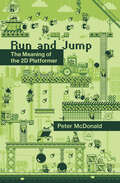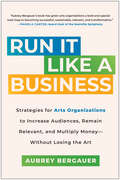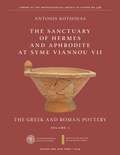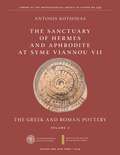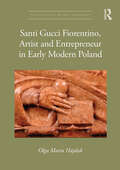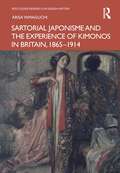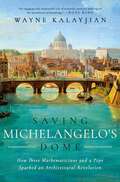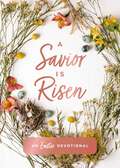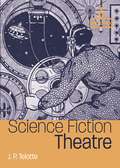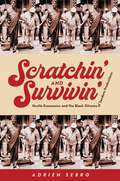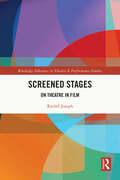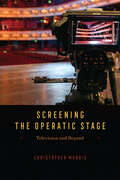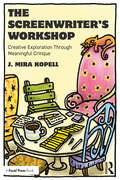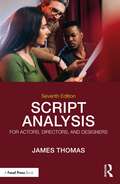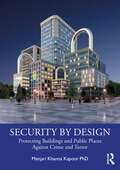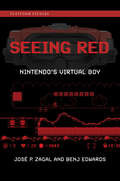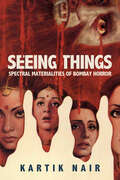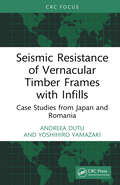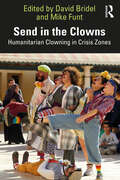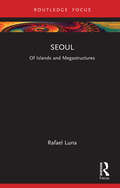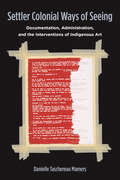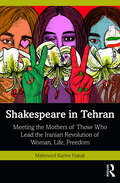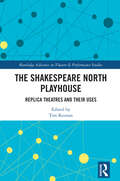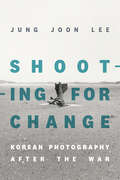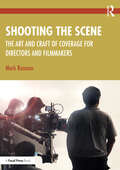- Table View
- List View
Run and Jump: The Meaning of the 2D Platformer (Playful Thinking)
by Peter D. McDonaldHow abstract design decisions in 2D platform games create rich worlds of meaning for players.Since the 1980s, 2D platform games have captivated their audiences. Whether the player scrambles up the ladders in Donkey Kong or leaps atop an impossibly tall pipe in Super Mario Bros., this deceptively simple visual language has persisted in our cultural imagination of video games. In Run and Jump, Peter McDonald surveys the legacy of 2D platform games and examines how abstract and formal design choices have kept players playing. McDonald argues that there is a rich layer of meaning underneath, say, the quality of an avatar&’s movement, the pacing and rhythm of level design, the personalities expressed by different enemies, and the emotion elicited by collecting a coin.To understand these games, McDonald draws on technical discussions by game designers as well as theoretical work about the nature of signs from structuralist semiotics. Interspersed throughout are design exercises that show how critical interpretation can become a tool for game designers to communicate with their players. With examples drawn from over forty years of game history, and from games made by artists, hobbyists, iconic designers, and industry studios, Run and Jump presents a comprehensive—and engaging—vision of this slice of game history.
Run It Like a Business: Strategies for Arts Organizations to Increase Audiences, Remain Relevant, and Multiply Money--Without Losing the Art
by Aubrey BergauerFeatured on Publishers Weekly 2024 Announcement IssueTEDx speaker Aubrey Bergauer—&“the Steve Jobs of classical music&”—reveals how to run a successful arts business in the post-pandemic era, adapting for-profit methods for not-for-profit goals.In the US alone, the arts are a $763 billion sector whose 100,000+ organizations serve almost every community in the nation. There&’s no reason arts organizations should struggle to make ends meet. And now, with arts-tested strategies from Aubrey Bergauer, they won&’t. This foolproof guide shows how to reach new levels of engagement—while always putting art first.Running your arts organization like a business is your path forward to:Grow audiences and keep them coming back againMake our organizations more inclusiveGet younger attendees in the seats and on the donor rollsGenerate millions more dollars in revenueContinue to create the art we love—without the stress of figuring out how to afford itJust because arts organizations are non-profits doesn&’t mean they shouldn&’t make money; it means the money they make goes back to fund the mission—whether that&’s music, visual arts, theatre, dance, or one of many other mediums that enrich our lives.The for-profit world knows how to achieve success across customer engagement, user experience, company culture, the subscription economy, technology and media, new revenue streams, and brand relevance. Run It Like a Business provides a powerful, proven framework to help all arts organizations revitalize their economic engines and ultimately serve the arts and its patrons.
Sanctuary of Hermes and Aphrodite at Syme Viannou VII, Part 1, The: The Greek and Roman Pottery (ISAW Monographs)
by Antonis KotsonasNew insights from the archaeology and pottery of the sanctuary of Hermes and Aphrodite at Syme Viannou, Crete The Sanctuary of Hermes and Aphrodite at Syme Viannou VII: The Greek and Roman Pottery presents in two volumes the Greek and Roman pottery recovered from the excavation of the sanctuary of Syme Viannou, one of the most long-lived and important cult sites of ancient Crete and the Aegean. The site, which is known as the Cretan Delphi, was dedicated to Hermes and Aphrodite for much of its history. The present study analyzes and catalogs 865 pieces, dating from across the early first millennium BCE to the mid-first millennium CE. Kotsonas integrates traditional typological and chronological inquiries with contextual considerations, macroscopic and petrographic analyses of ceramic fabrics, and quantitative studies. The resulting work provides detailed documentation of the pottery from Syme Viannou and explores its ritual and other roles within the diachronic panorama of cultic and other activities at the site. It also supports a broader understanding of the role of ceramics in sanctuary contexts by introducing systematically comparative perspectives on the evidence of pottery from other Cretan and Greek sanctuaries.Volume 1 provides an introduction to the site of the sanctuary of Syme Viannou and its history, and contains an analytical catalog of the ceramic remains.
Sanctuary of Hermes and Aphrodite at Syme Viannou VII, Vol. 2, The: The Greek and Roman Pottery (ISAW Monographs)
by Antonis KotsonasNew insights from the archaeology and pottery of the sanctuary of Hermes and Aphrodite at Syme Viannou, Crete The Sanctuary of Hermes and Aphrodite at Syme Viannou VII: The Greek and Roman Pottery presents in two volumes the Greek and Roman pottery recovered from the excavation of the sanctuary of Syme Viannou, one of the most long-lived and important cult sites of ancient Crete and the Aegean. The site, which is known as the Cretan Delphi, was dedicated to Hermes and Aphrodite for much of its history. The present study analyzes and catalogs 865 pieces, dating from across the early first millennium BCE to the mid-first millennium CE. Kotsonas integrates traditional typological and chronological inquiries with contextual considerations, macroscopic and petrographic analyses of ceramic fabrics, and quantitative studies. The resulting work provides detailed documentation of the pottery from Syme Viannou and explores its ritual and other roles within the diachronic panorama of cultic and other activities at the site. It also supports a broader understanding of the role of ceramics in sanctuary contexts by introducing systematically comparative perspectives on the evidence of pottery from other Cretan and Greek sanctuaries.Volume 2 presents synthetic studies of the material, exploring the use of different ceramic fabrics, the relationship between the form and function of the vessels, and the place of ceramic items in the cultic practice and daily life at the sanctuary in Greek and Roman antiquity.
Santi Gucci Fiorentino, Artist and Entrepreneur in Early Modern Poland (ISSN)
by Olga Maria HajdukThe original research in this book analyzes the artistic activity of Santi Gucci (1533– c.1600), a Florentine sculptor active in Poland in the second half of the sixteenth century, and his workshop.Chapters examine the organization of the artistic workshop (sculpting and masonry) and the model of the artist’s functioning as an entrepreneur in Renaissance Poland, using Santi Gucci’s activity as an example. Gucci shaped the image of Polish sculpture in the sixteenth century for more than 50 years, even though his work has not yet been fully examined. The author sets Gucci’s emigration within the context of the cultural exchanges between Italy and Poland that contributed to the development of the Polish Renaissance.The book will be of interest to scholars working in art history, Renaissance studies, architectural history and economic history.
Sartorial Japonisme and the Experience of Kimonos in Britain, 1865-1914 (Routledge Research in Design History)
by Arisa YamaguchiUsing interdisciplinary research and critical analysis, this book examines experiences through (or with) kimonos in Britain during the late Victorian and Edwardian periods. Bringing new perspectives to challenge the existing model of ‘Japonisme in fashion’ and introducing overlooked contacts between kimonos and people, this book explores not only fine arts and department stores but also a variety of theatres and cheap postcards. Putting a particular focus on the responses and reactions elicited by kimonos in visual, textual and material forms, this book initiates an entirely new discussion on the British adoption of Japanese kimonos beyond the monolithic view of the relationship between the East and West. This book will be of interest to scholars working in fashion studies, British studies, Japanese studies, design history and art history.
Saving Michelangelo's Dome: How Three Mathematicians and a Pope Sparked an Architectural Revolution
by Wayne KalayjianIn 1742, when the legendary dome atop St. Peter&’s Basilica—designed by Michelangelo—cracks and threatens to collapse, Pope Benedict XIV summons three mathematicians to help, whose revolutionary ideas spark a chain of events that will change the world of architecture forever.1742: the famous dome atop Saint Peter&’s Basilica, designed by Michelangelo, is fractured and threatened with collapse. The dome is the pride of Italy and the largest of its kind anywhere in the world. And no one knows how to fix it. This engaging and colorful narrative tells the overlooked story of how Michelangelo&’s Dome was saved from disaster by three mathematicians and Pope Benedict XIV, who had asked them for help. It is a gripping story of decisive leadership, crisis management, and scientific innovation, and the resistance that was faced when sailing into the headwinds of conventional thought. In Saving Michelangelo's Dome, Stanford-trained engineer Wayne Kalayjian illustrates how new ideas in science and mathematics established an entirely new way of looking at the world—as well as solving its complex problems. In the end, readers will appreciate that in saving Michelangelo&’s Dome from collapse, these three mathematicians and one determined pope unknowingly invented the profession of engineering as we practice it today. With it, they transformed the architectural world and ushered in generations of future buildings and structures that, otherwise, would never have been built.
A Savior Is Risen: An Easter Devotional
by Susan HillDo less. Connect more. This beautiful 40-day devotional for the Lenten and Easter season offers biblical reflections and full-color springtime photography to take you from burnout to burning a little brighter as you celebrate new life, fresh starts, and everyday redemptions.It's a distracted world out there. Maybe you find yourself scrolling more than savoring, texting more than resting, and rushing instead of taking a deep breath. The things you thought would bring connection make you feel more disconnected than ever, with a good dose of exhaustion thrown in. It's time for a reset.A Savior Is Risen is a 40-day journey from Ash Wednesday to Easter morning, a call for you to quiet your mind and soul as you focus on Jesus and His resurrection.In this gorgeous devotional, you are invited to:Experience the Easter season with fresh eyes and an expectant heartPractice a modern-day fast from the things distracting you from GodReflect on Jesus' life and ResurrectionDraw closer to God through silence and reflectionLet go of stress and embrace grace Each day's entry includes:A word that embodies the spirit of EasterA brief reflection on integrating that word into your lifeA Scripture passage for meditationA prayer to bring peace to your mindBright springtime photography that captures the beauty of new life A Savior Is Risen is ideal for anyone wanting permission to slow down, as a gift for someone looking for spiritual renewal, or as a beautiful book to display as a reminder of God's promises. So grab your morning coffee or afternoon chai, and feel your spirit settle as you immerse yourself the ultimate new beginning God has given us all.
Science Fiction Theatre (TV Milestones Series)
by J. P. TelotteIn the wake of the juvenile space operas of the early 1950s, a groundbreaking series debuted and paved the way for one of viewers’ favorite genres today: adult-oriented science fiction. Science Fiction Theatre aired with a fresh anthology-style narrative from the vision of veteran producer Ivan Tors and with compelling narration by Truman Bradley. Created by industry-leading syndicator Ziv Television Programs, the show pioneered a scientifically based approach to aliens, telepathy, and the mysteries of the universe that provided a model for Rod Serling’s The Twilight Zone (1959–64) and a myriad of acclaimed programs that followed, including The Outer Limits (1963–65), The Ray Bradbury Theater (1985–92),and Black Mirror (2011–present). This book contextualizes Science Fiction Theatre within the budding American television industry of the 1950s, as powerful networks and independent producers and syndicators vied to create and distribute programming to an audience eager to embrace this new, free medium. Including a complete videography of this historically neglected series, author J. P. Telotte illuminates Science Fiction Theatre as a touchstone for understanding the development of science fiction media and the dynamic nature of early television broadcasting.
Scratchin' and Survivin': Hustle Economics and the Black Sitcoms of Tandem Productions
by Adrien SebroThe 1970s was a golden age for representations of African American life on TV sitcoms: Sanford & Son, Good Times, The Jeffersons. Surprisingly, nearly all the decade’s notable Black sitcoms were made by a single company, Tandem Productions. Founded by two white men, the successful team behind All in the Family, writer Norman Lear and director Bud Yorkin, Tandem gave unprecedented opportunities to Black actors, writers, and producers to break into the television industry. However, these Black auteurs also struggled to get the economic privileges and creative autonomy regularly granted to their white counterparts. Scratchin’ and Survivin’ discovers surprising parallels between the behind-the-scenes drama at Tandem and the plotlines that aired on their sitcoms, as both real and fictional African Americans devised various strategies for getting their fair share out of systems prone to exploiting their labor. The media scholar Adrien Sebro describes these tactics as a form of “hustle economics,” and he pays special attention to the ways that Black women—including actresses like LaWanda Page, Isabel Sanford, and Esther Rolle—had to hustle for recognition. Exploring Tandem’s complex legacy, including its hit racially mixed sitcom Diff’rent Strokes, he showcases the Black talent whose creative agency and labor resilience helped to transform the television industry.
Screened Stages: On Theatre in Film (ISSN)
by Rachel JosephThis book is devoted to tracing the variety of ways that theatre, theatricality, and performance are embedded in Hollywood cinema as screened stages.A screened stage is the literal or metaphorical appearance of a stage on screen. When the Hollywood style emerged in cinema history it traumatically severed the entwined relationship between film and theatre. The book makes the argument that cinema longs for theatre after that separation. The histories of stage and screen persistently crisscross one another making their separation problematic. The screened stage from the end of the nineteenth century until now offers a miniaturized version of cinema and theatre history. Moments of the stage within the screen compress historical styles and movements into saturated representations on film. Such examples overflow the cinematic screen into singular manifestations of presentness. Screened stages uncover what it means to be simultaneously present and absent.This book would be of great interest to students and scholars of theatre, film, dance, and performance.
Screening the Operatic Stage: Television and Beyond (Opera Lab: Explorations in History, Technology, and Performance)
by Christopher MorrisAn ambitious study of the ways opera has sought to ensure its popularity by keeping pace with changes in media technology. From the early days of television broadcasts to today’s live streams, opera houses have embraced technology as a way to reach new audiences. But how do these new forms of remediated opera extend, amplify, or undermine production values, and what does the audience gain or lose in the process? In Screening the Operatic Stage, Christopher Morris critically examines the cultural implications of opera’s engagement with screen media. Foregrounding the potential for a playful exchange and self-awareness between stage and screen, Morris uses the conceptual tools of media theory to understand the historical and contemporary screen cultures that have transmitted the opera house into living rooms, onto desktops and portable devices, and across networks of movie theaters. If these screen cultures reveal how inherently “technological” opera is as a medium, they also highlight a deep suspicion among opera producers and audiences toward the intervention of media technology. Ultimately, Screening the Operatic Stage shows how the conventions of televisual representation employed in opera have masked the mediating effects of technology in the name of fidelity to live performance.
The Screenwriter’s Workshop: Creative Exploration Through Meaningful Critique
by J. Mira KopellThrough a series of carefully designed writing workshops, this book guides the screenwriter through the messy creativity of screenwriting. Drawing on over 20 years’ experience facilitating screenwriting workshops, author J. Mira Kopell provides readers with a path to screenwriting that makes space for reflection, critique, and exploration. Structured around five specific writing assignments, each assignment supports the writer forward incrementally by focusing on a specific set of craft elements needed to then move them on to the next. A key value of the assignments is that they are not exercises but steps in the development of the writer's own screenplay. By using this book, readers can both receive meaningful feedback on their own project and learn to give insightful, focused critiques of their fellow writer’s work. Rather than offering craft as a “to-do” list that promises successful scripts, this book reimagines craft as “tools not rules,” empowering a writer to let their unique story dictate choices in order to support their work and honor their own voice. This book is ideal for students and lecturers of screenwriting, groups of writers looking to form their own workshops, and aspiring professionals wanting to develop their craft.
Script Analysis for Actors, Directors, and Designers
by James ThomasScript Analysis for Actors, Directors, and Designers, Seventh Edition, teaches the skills of script analysis using a formalist approach that examines the written part of a play to evaluate its potentials for performance and production. This new edition features new and revised content, including an analysis of two new plays, Kalidasa’s Shakuntala and Federico Garcia Lorca’s The House of Bernarda Alba; information for the theatre designer integrated in chapters throughout the book; and an expanded appendix on critical approaches to script analysis. Explorations of both classic and unconventional plays are combined with clear examples, end-of-chapter summaries, and stimulating questions that will allow actors, directors, and designers to immediately incorporate the concepts and processes into their theatre production work. An excellent resource for students of acting, script analysis, directing, playwriting, and stage design courses, this book provides the tools to effectively bring a script to life on stage.
Security by Design: Protecting Buildings and Public Places Against Crime and Terror
by Manjari Khanna KapoorThis is a book about the intersection of architecture and security, about effective crime prevention and counterterror using the built form. While security professionals continue their strive towards alleviating our fear of crimes, and whilst methodologies like CPTED (Crime Prevention Through Environmental Design) have demonstrated the impact of design on prevention of crime over the last five decades, too many built environment professionals are not aware of these strategies. This book starts with the premise that there is a huge role for the design fraternity (namely architects and planners) in achieving realistic, efficient and permanent results, and ultimately in creating a safer world. It seeks to present such strategies in a palatable way and encourage professionals to incorporate security thinking into their design process as second nature. Combining international case studies including One World Trade Centre, New York; WHO Headquarters Extension Building, Geneva; and the Akshardham Temple, New Delhi, along with numerous examples from the author’s professional career, this book offers a systematic approach to integrating security into built environment design for easy adoption by architects, planners, security professionals and policymakers.
Seeing Red: Nintendo's Virtual Boy (Platform Studies)
by Jose P. Zagal Benj EdwardsThe curious history, technology, and technocultural context of Nintendo&’s short-lived stereoscopic gaming console, the Virtual Boy.With glowing red stereoscopic 3D graphics, the Virtual Boy cast a prophetic hue: Shortly after its release in 1995, Nintendo's balance sheet for the product was "in the red" as well. Of all the innovative long shots the game industry has witnessed over the years, perhaps the most infamous and least understood was the Virtual Boy. Why the Virtual Boy failed, and where it succeeded, are questions that video game experts José Zagal and Benj Edwards explore in Seeing Red, but even more interesting to the authors is what the platform actually was: what it promised, how it worked, and where it fit into the story of gaming.Nintendo released the Virtual Boy as a standalone table-top device in 1995—and quickly discontinued it after lackluster sales and a lukewarm critical reception. In Seeing Red, Zagal and Edwards examine the device's technical capabilities, its games, and the cultural context in the US in the 1990s when Nintendo developed and released the unusual console. The Virtual Boy, in their account, built upon and extended an often-forgotten historical tradition of immersive layered dioramas going back 100 years that was largely unexplored in video games at the time. The authors also show how the platform's library of games conveyed a distinct visual aesthetic style that has not been significantly explored since the Virtual Boy's release, having been superseded by polygonal 3D graphics. The platform's meaning, they contend, lies as much in its design and technical capabilities and affordances as it does in an audience's perception of those capabilities. Offering rare insight into how we think about video game platforms, Seeing Red illustrates where perception and context come, quite literally, into play.
Seeing Things: Spectral Materialities of Bombay Horror (South Asia Across the Disciplines)
by Kartik NairIn 1980s India, the Ramsay Brothers and other filmmakers produced a wave of horror movies about soul-sucking witches, knife-wielding psychopaths, and dark-caped vampires. Seeing Things is about the sudden cuts, botched makeup effects, continuity errors, and celluloid damage found in these movies. Kartik Nair reads such "failures" as clues to the conditions in which the films were made, censored, and seen, offering a view from below of the world's largest film culture. By combining close analysis with extensive archival research and original interviews, Seeing Things reveals the spectral materialities informing the genre's haunted houses, grotesque bodies, and graphic violence.
Seismic Resistance of Vernacular Timber Frames with Infills: Case Studies from Japan and Romania
by Andreea Dutu Yoshihiro YamazakiThis book provides an engineer’s perspective on the traditional construction methods for timber frames with infills, focusing on traditional paianta houses in Romania and minka houses in Japan to provide insights into the construction, seismic behavior, and design considerations of such structures.The nuances of each country’s traditional construction methods are considered, as well as the shared seismic culture and the similar functionality and local materials used for the houses, plus challenges from earthquake loading and fire. The efforts to preserve traditional houses in Romania are contrasted with Japan’s regulatory framework for traditional residential construction methods. Strengthening solutions are also proposed for timberframed houses with infills, considering various causes of degradation.• Introduces examples from non- seismic and seismic- prone countries.• Provides a comparative analysis of worldwide examples.• Presents design examples illustrating the integration of traditional architecture with modern design standards.The book serves as a comprehensive guide to the engineering intricacies of traditional houses in Romania and Japan for engineers and architects, with practical applications for new constructions worldwide.
Send in the Clowns: Humanitarian Clowning in Crisis Zones
by David Bridel Mike FuntSend in the Clowns presents interviews with twenty-four pioneering humanitarian and activist clowns and thought leaders working in hospitals, refugee camps, orphanages and war zones, and at the sites of street protests and locations of social unrest across the world.This book is built around interviews with some of the world’s leading practitioners of clowning for change, justice, and health outside of the entertainment mainstream, featuring artists and organizations including Patch Adams (US), the Dream Doctors Project (Israel), Clown Me In (Lebanon), and Doutores da Alegria (Brazil). Situating the topic in relation to indigenous and ritual clowning, investigating the various functions of the clown in early societies, and centering the discourse around interviews with key practitioners, the book explores a wide range of clown applications across the globe. This includes the special significance of the clown archetype in socially, politically, and culturally challenging situations, the successes and challenges of the art activists who are at the forefront of this movement, and the modern humanitarian clown’s relationship to original forms of clowning that can be traced back through history.This is a vital resource for anyone studying, teaching, or practicing clown work in applied contexts, from health care to conflict resolution.
Seoul: Of Islands and Megastructures (ISSN)
by Rafael LunaThis book focuses on understanding how a megacity like Seoul can be read as a formal architectural composition and not an endless urban sprawl.In a broader sense, the book discusses the dichotomy between city and urbanization: “city” being an architectural problem of bounded forms, while “urbanism” is an infrastructural project of expansion. It is an uncontested reality that urbanization is a continuous global process that has produced nebulous conurbations labeled as megacities. These expand beyond the virtual administrative boundary of any said “city,” producing a discrepancy between an area of administrative control and the real physical condition of human settlement. If there were a better formal understanding of megacities through their typological architectural conditions, then there could be a better assessment of the qualitative state of urbanization. Avant-garde groups from the 1950s, 1960s, and 1970s such as Team X, the Situationist, the Structuralist, and the Metabolist worked with ideas of megaforms and megastructures to address this issue. Although most of these proposals remained as paper architecture, this book reevaluates some of these ideas for the 21st-century megacity, using Seoul as a case study due to its clear typological formations produced over its diff erent periods of governance. The aim is to present the concept for an infra-architectural hybrid model of typological islands and subterranean megastructure that organizes Seoul as a fl exible multi-linear city.This book will be of interest to academics and students of architecture, urban geography, and Asian studies.
Settler Colonial Ways of Seeing: Documentation, Administration, and the Interventions of Indigenous Art
by Danielle Taschereau MamersAn innovative analysis of Indigenous strategies for overcoming the settler state.How do bureaucratic documents create and reproduce a state’s capacity to see? What kinds of worlds do documents help create? Further, how might such documentary practices and settler colonial ways of seeing be refused?Settler Colonial Ways of Seeing investigates how the Canadian state has used documents, lists, and databases to generate, make visible—and invisible—Indigenous identity. With an archive of legislative documents, registration forms, identity cards, and reports, Danielle Taschereau Mamers traces the political and media history of Indian status in Canada, demonstrating how paperwork has been used by the state to materialize identity categories in the service of colonial governance. Her analysis of bureaucratic artifacts is led by the interventions of Indigenous artists, including Robert Houle, Nadia Myre, Cheryl L’Hirondelle, and Rebecca Belmore. Bringing together media theories of documentation and the strategies of these artists, Settler Colonial Ways of Seeing develops a method for identifying how bureaucratic documents mediate power relations as well as how those relations may be disobeyed and re-imagined.By integrating art-led inquiry with media theory and settler colonial studies approaches, Taschereau Mamers offers a political and media history of the documents that have reproduced Indian status. More importantly, she provides us with an innovative guide for using art as a method of theorizing decolonial political relations. This is a crucial book for any reader interested in the intersection of state archives, settler colonial studies, and visual culture in the context of Canada’s complex and violent relationship with Indigenous peoples.
Shakespeare in Tehran: Meeting the Mothers of Those Who Lead the Iranian Revolution of Woman, Life, Freedom
by Mahmood Karimi HakakShakespeare in Tehran is a personal history of Iran through the eyes of an award-winning Iranian American artist. Drawing on parallels between life and the stage, it uses A Midsummer Night’s Dream as a roadmap to explore social, political, economic, and cultural aspects of Iran before and after the revolution of 1979. Through first-person accounts, interspersed with emotional reflections of the universal human experience, it delves into the historical and sociological context of a divided country. Storytelling, flashbacks, and flashforwards paint an intimate picture of public life in Iran in a time of uncertainty. Accessible, engaging, and nuanced, this volume will be of interest to scholars and researchers of politics, history, theater and performance studies, and West Asian studies.
The Shakespeare North Playhouse: Replica Theatres and Their Uses (ISSN)
by Tim KeenanThis collection celebrates the opening of the Shakespeare North Playhouse (SNP). After discussion of its genesis and development by four people pivotal to its progress at different stages of the project, this book explores different aspects of the SNP’s purpose and functions across three broad categories: buildings and spaces, practices and performance, and community arts and education. Various chapters offer answers to fundamental questions about replica theatres, including: Why do we build them? What do they do? How do we use them? In the course of these discussions, the purposes, potential, and programming of the SNP are discussed in relation to other Globe-type replicas in the UK and beyond. Contributors to this collection analyse key academic and practice-based concerns within their fields of expertise connected to the use (and misuse) of replica theatres to suggest the ways in which they can be used to drive research and practice in contemporary Shakespearean performance, connect with young people, and serve local communities.This book will appeal to academics, students, and practitioners interested in historical and contemporary approaches to Shakespeare in the fields covered. It should also appeal to general readers with an interest in the topics, particularly in Merseyside and the North-West region.
Shooting for Change: Korean Photography after the War
by Jung Joon LeeIn Shooting for Change, Jung Joon Lee examines postwar Korean photography across multiple genres and practices, including vernacular, art, documentary, and archival photography. Tracing the history of Korean photography while considering what is disguised or lost by framing the history of photography through nationhood, Lee considers the role of photography in shaping memory of historical events, representing the ideal national family, and motivating social movements. Further, through an investigation of what it means to practice photography under the normalized conditions of militarism, Lee treats the transnational militarism of Korea as a lens through which to probe the officially and culturally sanctioned readings of images when returning to them at different times. Among other themes, Lee draws on photography of militarized sex work, political protest in the military era, war orphans, and mass protests. Ultimately, Lee treats the formative periods in nation building and transnational militarization as both backdrop and cultivator for photographic works.
Shooting the Scene: The Art and Craft of Coverage for Directors and Filmmakers
by Mark RosmanNavigating the necessary skills for shooting fiction film or TV is a challenge for any filmmaker. This book demystifies the art and craft of “coverage”—explaining where to put the camera to shoot any kind of scene.Author Mark Rosman takes readers step by step through the basics such as scene analysis, blocking actors, composition, shot listing, storyboarding, and screen direction to the more advanced, including how to shoot fights, car chases, and visual effects scenes. Rosman draws on his extensive film career to reveal the tips and tricks professional directors use to shoot creatively, quickly, and effectively on any budget and design the perfect shooting plan to make memorable and impactful film and TV. Through simple descriptions, clearly drawn diagrams, storyboard panels, and frames from famous movies, this book is a comprehensive and in-depth look at the art and craft of mastering coverage.Ideal for students of directing and film production as well as any filmmaker looking for a guide to shooting any scene.Includes two bonus online chapters covering on set procedure and how to watch your dailies.
